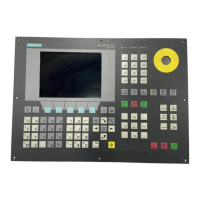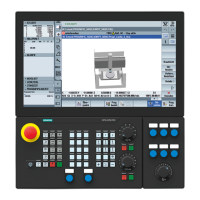W1: Tool offset
18.11 Sum offsets and setup offsets
Basic Functions
1560 Function Manual, 09/2011, 6FC5397-0BP40-2BA0
A setup data set requires an equal amount of memory. A certain number of bytes is also required for internal
administration data.
18.11.3 Activation
Function
The function must be activated via the machine data:
MD18108 $MN_MM_NUM_SUMCORR (sum offsets in TO area).
System variables $TC_ECPx and $TC_SCPx and setup and sum offsets ("fine") defined via the OPI interface can
be activated in the part program.
This is done by programming the language command DL="number".
When a new D number is activated, either a new DL number is programmed, or the DL number defined via the
following machine data becomes active:
MD20272 $MC_SUMCORR_DEFAULT (basic setting of the additive offset without a program)
DL programming
The sum offset is always programmed relative to the active D number with the command:
DL = "n"
The sum offset "n" is added to the wear of the active D number.
The sum offset is deselected with the command:
DL = 0
Note
If you use "setup offset" and "sum offset fine", both compensations are combined and added
to the tool wear.
Note
DL0 is not allowed. If compensation is deselected (D0 and T0), the sum offset also becomes
ineffective.
Programming a sum offset that does not exist triggers an alarm, similar to programming a D
compensation that does not exist.
Thus, only the defined wear remains part of the compensation (defined in system variables
$TC_DP12 to $TC_DP20).
Programming a sum offset when a D compensation is active (also applies to deselection) has
the same effect on the path as programming a D command. An active radius compensation
will, therefore, lose its reference to adjacent blocks.
